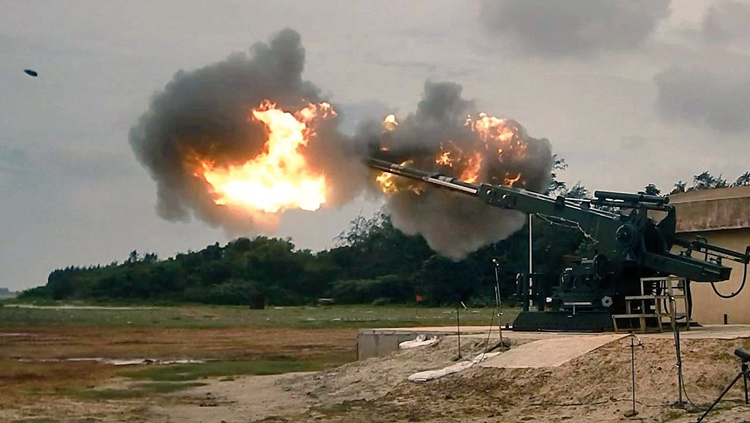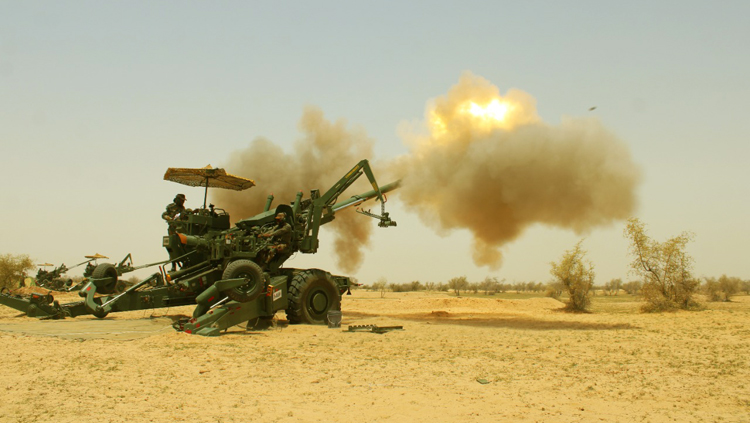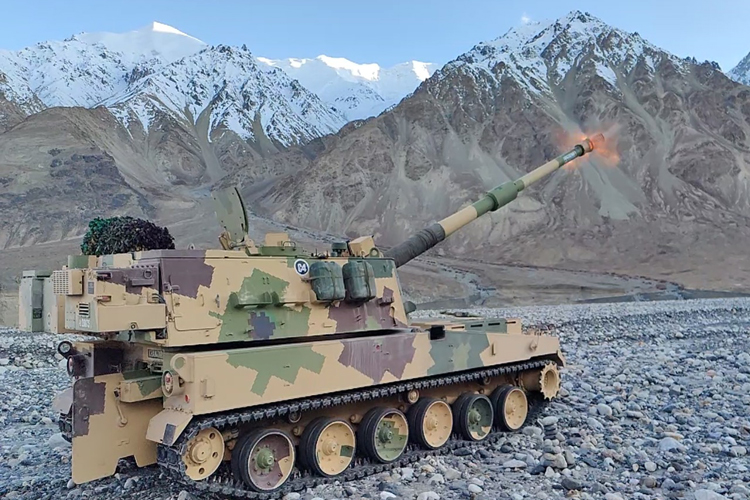INDIAN ARMED FORCES CHIEFS ON OUR RELENTLESS AND FOCUSED PUBLISHING EFFORTS

The insightful articles, inspiring narrations and analytical perspectives presented by the Editorial Team, establish an alluring connect with the reader. My compliments and best wishes to SP Guide Publications.

"Over the past 60 years, the growth of SP Guide Publications has mirrored the rising stature of Indian Navy. Its well-researched and informative magazines on Defence and Aerospace sector have served to shape an educated opinion of our military personnel, policy makers and the public alike. I wish SP's Publication team continued success, fair winds and following seas in all future endeavour!"

Since, its inception in 1964, SP Guide Publications has consistently demonstrated commitment to high-quality journalism in the aerospace and defence sectors, earning a well-deserved reputation as Asia's largest media house in this domain. I wish SP Guide Publications continued success in its pursuit of excellence.
- MoD initiates comprehensive review of Defence Acquisition Procedure 2020, pushes for defence reforms
- G7: The Swansong
- Kalinga Connect: South Asia to Polynesia
- Must Credit DRDO for Operation Sindoor, now what is next for defence R&D?
- The layered Air Defence systems that worked superbly, the key element of Operation Sindoor
- Operation Sindoor | Day 2 DGMOs Briefing
- Operation Sindoor: Resolute yet Restrained
400 Indigenous Towed Gun-Systems
Indian Army Pursues 400 Indigenous Howitzers for Future Artillery Advancements
 |
The Author is Former Director General of Information Systems and A Special Forces Veteran, Indian Army |

Concurrent with the celebration of the 197th Gunners Day on September 28, 2023, marking the establishment of the first artillery company in 1748 by the East India Company, the Indian Army has submitted a proposal to the Ministry of Defence (MoD) to purchase 400 indigenous howitzers. Media reports quote a senior military officer as stating that the Indian Army’s Regiment of Artillery aims to harness the expertise of Indian Industry to produce a 155mm/52 calibre Towed Gun System (TGS) that will be lighter, more versatile, and poised for future technological advancements. The official further stated, “A proposal for acquiring 400 155mm/52 calibre towed gun systems (TGS) along with towing vehicles from Indian firms under the Buy Indian-IDDM category has been forwarded to the Defence Ministry. A decision on the TGS is expected to be reached soon at a high-level meeting.”
The Indian Army has already issued a tender for the acquisition of 307 Advanced Towed Artillery Gun Systems (ATAGS) and one for finding a mounted gun system to meet its requirements along the borders with China and Pakistan. However, sources within the defence and security establishment have informed the media that while a Request for Proposal (RFP) for ATAGS has been sent to the indigenous firms Kalyani Group and Tata Advanced Systems Limited (TASL), the Army is, in reality, focused on the much lighter and more agile TGS, which incorporates more automation than ATAGS.
A proposal to procure 400 155mm/52 calibre Towed Gun Systems (TGS) from Indian firms has been submitted to the Ministry of Defence (MoD), aiming to leverage local industry expertise.
In December 2022, the Indian Army also issued a fresh Request for Information (RFI) to acquire a 155mm/52 calibre TGS, specifying that the weight of the gun system "preferably be less than 15 tonnes," whereas the ATAGs weigh over 18 tonnes. This raised speculation about the Autonomous Towed Howitzer Ordnance System (ATHOS), manufactured by the Israeli firm Elbit, which had been under consideration for over a decade.

The TGS will not be the indigenous Dhanush or the Advanced Towed Artillery Gun (ATAGS), but rather the new 155mm/52 Calibre Towed Gun System, which will be the primary artillery piece in the future. The Army aims for the TGS guns to be operable in all types of terrain while being lighter in weight and easier to deploy in high-altitude areas, akin to the older Bofor guns. The TGS forms a crucial part of the Army’s plan for the ‘Mediumisation’ of its artillery with indigenous guns, anticipated to conclude by the year 2042. Procuring TGS under the Indian Designed, Developed and Manufactured (IDDM) process implies that this gun system will be 100 per cent indigenous.
In the past decade, four contracts have been finalised for the procurement of 155mm howitzers. These Gun Systems have already been integrated, with additional Regiments being equipped with these guns. These gun systems include Dhanush, Sharang, Ultra Light Howitzer (ULH), and K9 Vajra Self Propelled Guns. Dhanush Guns represent an electronic upgrade of Bofors Guns, while the Sharang Guns have been up-gunned from 130mm to 155mm calibre. Seven Regiments have already been equipped with ULHs, while five have been supplied with self-propelled guns.
Differentiating from the Advanced Towed Artillery Gun Systems (ATAGS), the TGS is envisioned to be more agile and automated, aligning with the Army's evolving requirements.
The Regiment of Artillery is currently in the process of procuring niche technologies including loitering munitions, swarm drones, and tactical remotely piloted aerial systems, according to a source cited in the media, who also mentioned, “As part of this process, significant upgrades are imminent in the Artillery Combat Command and Control System (ACCCS). The Battlefield Surveillance System (BSS) is also scheduled for imminent deployment.”
The timeline for completing the ‘Mediumisation’ of the artillery, including the 400 TGS by 2042, will hinge on the development, trials, fielding, and annual production capacity of the TGS. Nevertheless, other factors need consideration as well. It is imperative to strategise for accelerating production, particularly in light of the potential for a conflict with China that may not be too distant. The prospect of a Ukraine-type war during this period is another variable, along with estimating the attrition rate of gun systems in such a scenario. Currently, there are no available figures regarding the number of gun systems lost in the Ukraine war, only mention of approximately 2,000 tanks lost by each side.

A significant concern revolves around artillery ammunition. Both Russia and Ukraine employ artillery for both destruction and neutralisation, with reports indicating between 10,000-20,000 artillery rounds being discharged in a single day. Our track record in terms of ammunition quality is far from reassuring. Just three years ago, the Army communicated to the MoD that the quantity of faulty ammunition in storage could have financed the procurement of 100 medium artillery guns. The Ukraine war has also dispelled the notion that modern-era wars would always be brief and swift. This necessitates a reevaluation of our ammunition stocking, which we reduced from the former 40 days (intense) to 10 days (intense) a few years ago. Running out of ammunition during a conflict is a risk we can ill afford. Equally vital is the secure supply of ammunition to the frontline and the safeguarding of ammunition depots, which are prime targets for the enemy; ensuring these depots are not easily targeted by missiles or aircraft may necessitate underground fortifications.
The TGS, a pivotal component of the Army's 'Mediumisation' plan for indigenous artillery, is anticipated to be operational in diverse terrains and lightweight for deployment in high-altitude regions.
It is beyond dispute that the artillery is deficient in terms of gun systems. 'Mediumisation' must be expedited, and one pragmatic approach could involve adapting the assembly lines of the ATAGS to facilitate the acquisition of the TGS. However, it is crucial to bear in mind that the lighter TGS, even when deployed in fortified positions, can still be located and targeted by loitering munitions. Reflecting on the conflict in Ukraine, where artillery systems must fire and promptly change location, underscores the priority for self-propelled gun systems over towed gun systems. Notably, the first 50 Mahindra self-propelled mortars have been delivered to the Indian Army. The system comprises the Spanish 120mm Alakran Mortar System mounted on the Mahindra 4x4 ALSV Chassis. It boasts an excellent shoot-and-move capability, achieving repositioning in under 60 seconds, with a range of 8 km and the ability to be transported by Mi-17 helicopters.
In conclusion, it is not a matter of towed gun systems becoming obsolete, as targeting by drones and loitering munitions is equally applicable to tanks and mechanized formations. The prudent approach lies in attaining a balanced mix of towed gun systems (such as the TGS) and self-propelled gun systems (such as the K9 Vajra) for the artillery. It may be judicious to adopt a diversified configuration encompassing heavy mortars, field guns, and standard-calibre medium guns, including 155mm/52cal self-propelled variants in both mounted and tracked versions. For long-range capabilities, continued enhancements to our existing rocket force are imperative.





